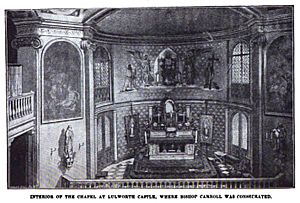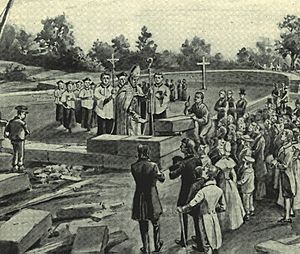John Carroll (archbishop of Baltimore) facts for kids
Quick facts for kids The Most Reverend John Carroll SJ |
|
|---|---|
| Archbishop of Baltimore | |
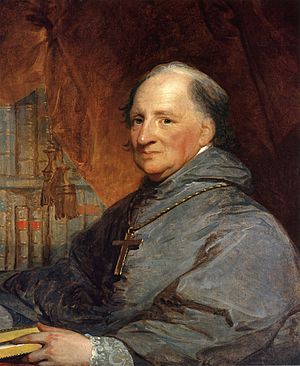 |
|
| Church | Catholic Church |
| Archdiocese | Baltimore |
| See | Baltimore |
| Appointed | November 6, 1789 |
| Enthroned | December 12, 1790 |
| Reign ended | December 3, 1815 |
| Predecessor | Diocese erected |
| Successor | Leonard Neale |
| Orders | |
| Ordination | February 14, 1761 |
| Consecration | August 15, 1790 by Charles Walmesley |
| Personal details | |
| Born | January 8, 1735 Marlborough Town, Province of Maryland |
| Died | December 3, 1815 (aged 80) Baltimore, Maryland, United States |
| Motto | Ne derelinquas nos domine deus noster ("Forsake us not, O Lord, my God, stay not far from me") |
| Coat of arms |  |
John Carroll SJ (January 8, 1735 – December 3, 1815) was an important American leader in the Catholic Church. He became the very first bishop and later archbishop in the United States. He led the first Catholic area, called a diocese, in Baltimore, Maryland. This area first covered the entire United States!
Carroll is also famous for starting Georgetown University. This is the oldest Catholic college in the United States. He also founded St. John the Evangelist Parish in Forest Glen, which was the first parish led by priests who weren't part of a special religious order.
Contents
Early Life and Education
John Carroll was born on January 8, 1735, in Upper Marlborough, Maryland. His parents were Daniel Carroll I and Eleanor Darnall Carroll. His family had Irish roots.
He grew up on a large family farm near Marlborough Town. His family was very important in the early days of Maryland. His older brother, Daniel Carroll II, signed both the "Articles of Confederation and Perpetual Union" and the U.S. Constitution. His cousin, Charles Carroll of Carrollton, signed the Declaration of Independence.
John Carroll was first taught at home by his mother. Then, he went to a secret Catholic school in Maryland. When he was 13, he traveled to France to study at the College of St. Omer. This school was for English Catholics who faced unfair treatment in England. His cousin Charles also went to St. Omer with him.
Becoming a Jesuit Priest
Carroll joined the Society of Jesus (the Jesuits) when he was 18, in 1753. He studied for many years and became a priest in 1761. He officially became a Jesuit in 1771.
Carroll lived in Europe for almost 40 years, teaching at schools. In 1773, the Pope decided to temporarily stop the Jesuit order in Europe. This was a difficult time for Carroll. Because of laws against Catholics in Maryland, there was no public Catholic Church there when he returned. So, Carroll worked as a missionary in Maryland and Virginia.
In 1774, Carroll started St. John the Evangelist Parish in Forest Glen.
Helping the American Revolution
In 1776, the Continental Congress asked Carroll to go on a special trip. He traveled with his cousin Charles Carroll, Samuel Chase, and Benjamin Franklin to Montreal, Canada. Their goal was to convince the French Canadians to join the American Revolution against the British. The trip wasn't successful, but it helped Carroll become known to other important American leaders.
After the American Revolution, Catholic priests in the United States needed to organize themselves. They met at White Marsh Manor in Maryland, starting in 1783. These meetings helped them gradually set up the Catholic Church in the new United States.
Leading the Missions
After the American Revolution, the Catholic clergy in the U.S. didn't want to be controlled by a British bishop. They wanted to be independent. The Pope's representative in France, Giuseppe Doria Pamphili, talked with Benjamin Franklin about this. Franklin said the U.S. government didn't have an official opinion on who should lead American Catholics. But he privately suggested John Carroll.
So, on June 9, 1784, Pope Pius VI chose John Carroll to be the "Superior of the Missions" for the United States. This meant he was the main leader for Catholics in the new country. The Pope made this decision partly because Benjamin Franklin had spoken so highly of Carroll.
Making Changes in the Church
In the new United States, the government didn't control churches like in other countries. This meant Catholics had different ideas about how to run their local churches. Carroll worked to find a balance between involving regular church members (the laity) and having proper leadership.
In 1791, John Carroll and other Catholic leaders signed a message congratulating President George Washington. This showed how Catholics were becoming part of the new nation.
Carroll also wrote articles to defend the Catholic faith against people who spoke badly about it. He believed Catholics and Protestants should work together to build the new country. He even suggested that if the Pope's role was clearer and if Mass was said in English, it would help Christians unite.
Becoming the First Bishop
At first, American priests were unsure about having a bishop in the U.S. They worried it might look like they were controlled by a foreign power. But they soon realized a bishop was needed. In 1783, the Protestant Episcopal Church in the U.S. got its first bishop, which showed that Americans accepted having bishops.
In 1784, the Pope created the "Apostolic Prefecture of the United States." Carroll, as the leader, asked the Pope to let American priests choose their own bishop. The Pope agreed, allowing the priests to suggest names.
In April 1789, the priests of the United States voted, and John Carroll was chosen to be the first Bishop of Baltimore. On November 6, 1789, Pope Pius VI approved this choice.
Carroll was officially made a bishop on August 15, 1790, in England. He then returned to Baltimore and began his work at St. Peter's Church. This church became his main church, or "pro-cathedral." It was the site of many "firsts" for the Catholic Church in the U.S., like the first ordination of a priest.
Starting Georgetown University
Carroll believed strongly in education. He wanted to make sure people could learn, priests were well-trained, and even women had access to higher education. Because of this, he helped start Georgetown College (now Georgetown University). It was built near the new U.S. capital, Washington, D.C. The Jesuits were put in charge of running the school. Classes began on November 22, 1791.
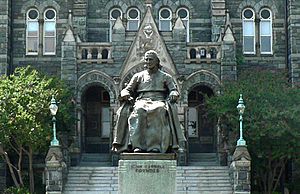
First Church Meeting in the U.S.
In 1791, Carroll held the first major meeting of Catholic priests in the United States. Twenty-two priests from different countries discussed important rules for the Church. They talked about things like baptism, marriage, and how to celebrate Mass. They also decided that church money should be divided: one-third for the priests, one-third for church buildings, and one-third for helping the poor.
Religious Orders in the Diocese
To train new priests, Carroll invited the Sulpician Fathers to Baltimore. They arrived in 1791 and started St. Mary's College and Seminary. Carroll also approved the founding of Visitation nuns, who started Visitation Academy in Georgetown in 1799.
In 1805, Carroll helped bring the Jesuits back to Maryland. They had been protected in Russia from the earlier suppression. He also encouraged English Dominican friars to start a college in Kentucky. In 1809, the Sulpicians invited Elizabeth Ann Seton to start a school in Emmitsburg, Maryland.
Building the First Cathedral
In 1806, Carroll began the construction of the first Catholic cathedral in the United States. It was called the Cathedral of the Assumption, and it's now known as the Basilica of the National Shrine of the Assumption of the Blessed Virgin Mary. It was designed by Benjamin Henry Latrobe, who also designed the United States Capitol. Carroll laid the first stone on July 7, 1806, but he passed away before it was finished.
Becoming an Archbishop
In 1808, Pope Pius VII made Baltimore the first archdiocese in the United States. This meant it was a very important Catholic area, with authority over other dioceses in places like Boston, New York, Philadelphia, and Bardstown. Archbishop Carroll then helped consecrate three new bishops in 1810.
Later Life and Death
John Carroll died in Baltimore on December 3, 1815. His body is buried in the crypt of the Basilica of the National Shrine of the Assumption of the Blessed Virgin Mary in Baltimore, which people can visit.
Supporting English in Church Services
Carroll believed that regular church members should be able to read the Bible more easily. He pushed for the readings during Mass to be in English, not just Latin. He also encouraged people to buy an English version of the Bible so they could read the Scriptures themselves.
He wanted to make many changes in the Church, especially about how priests behaved. He strongly supported using local languages (like English) in church services. However, the Church leaders at the time did not agree with him on this. It took almost 200 years for his wish for English-language services to come true in the United States, after the Second Vatican Council.
Views on Slavery
John Carroll owned two enslaved people, Charles and Alexis. In his will, he arranged for Charles to be freed within a year and gave him some money. Alexis was sold in 1806.
Carroll believed that enslaved people should be treated kindly and receive religious education. While he never pushed for slavery to be completely ended by law, his views changed over time. He came to support the idea of gradually freeing enslaved people. He thought that if masters freed their enslaved people over time, families could stay together, and older enslaved people could be cared for.
Legacy
| Styles of John Carroll |
|
|---|---|
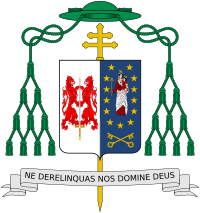 |
|
| Reference style | The Most Reverend |
| Spoken style | Your Excellency |
| Religious style | Monsignor |
| Posthumous style | none |
Many places and organizations are named after John Carroll:
- John Carroll University, a Jesuit university in Ohio.
- Several high schools across the country, including in Pennsylvania, Washington D.C., Ohio, Florida, and Alabama.
- The John Carroll School, in Bel Air, Maryland.
- The John Carroll Society, a group for Catholic professionals.
- A statue of Bishop John Carroll at Georgetown University.
- Carroll Square, an office building in Washington D.C.
- The town of Carrolltown, Pennsylvania.
- The "Mass for John Carroll," a popular church song written in his honor.
See also
 In Spanish: John Carroll (obispo) para niños
In Spanish: John Carroll (obispo) para niños
- Carroll family
- Catholic Church in the United States
- History of Catholicism in the United States



